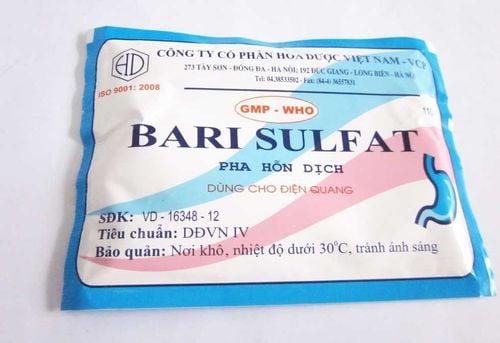This is an automatically translated article.
The article is professionally consulted by Master, Doctor Nguyen Viet Thu - Doctor of Radiology and Nuclear Medicine - Department of Diagnostic Imaging and Nuclear Medicine - Vinmec Times City International Hospital
Contrast drugs are used very widely in diagnostic imaging technology. This is a drug that has a larger intravenous dose than many other therapeutic agents, so the risk of contrast allergy is a significant medical problem. So does contrast injection have any effect?
1. Contrast is what drug?
Contrast is a drug used in the imaging process of X-ray machines (such as X-ray machines, CT computed tomography, DSA background digitized angiography). These are drugs that increase the contrast of structures or fluids inside the body. Therefore, contrast agents will clearly show the structures of organs with high concentration of drug, thereby supporting the diagnosis of diseases of these organs.
Contrast is often used to improve the visibility of blood vessels, gastrointestinal tract, urinary tract, body organs, tumor lesions, some biliary drugs to help diagnose diseases related biliary tract....
Contrast is increasingly widely used in imaging techniques, in which iodinated contrast agents are used most commonly. Although iodinated contrast agents are considered to be relatively safe, allergic reactions to contrast agents have occurred in a relatively large number of patients.
SEE ALSO: Contrast removal process

2. Allergic reactions to contrast media
Allergic reactions to contrast can be immediate or delayed.
● Immediate reactions: occur within 1 hour of contrast injection. These reactions may be mild (nausea, vomiting, mild urticaria, pallor), moderate (profuse vomiting, widespread urticaria, dyspnea, severe, laryngeal edema) or severe (pulmonary edema, cardiac arrhythmias) or cardiac arrest, circulatory collapse, coronary vasospasm are a serious complication of contrast agent allergy during coronary angiography). Immediate response rates to contrast ranged from 0.01 to 0.04% for severe reactions and 3% for mild reactions. This is an allergic reaction to contrast that mainly occurs with patients right at the imaging facilities.
● Slow reactions, occurring a few hours to several weeks after contrast injection, are usually self-limited and have only cutaneous manifestations (rash, erythema, urticaria, angioedema), which may be accompanied by fever. .
Contrast allergy may or may not be related to IgE mediators. Several studies have hypothesized that the mechanism of allergic reactions is due to the direct activation of Mast cells (also known as mastocytes or labrocytes), activation of coagulation pathways, kinins, and complement, inhibits platelet aggregation, increases serotonin release and inhibits cholinesterase enzymes.
MORE: Side effects, unwanted effects and allergies when using contrast agents

3. Risk factors that increase the incidence of contrast agent allergy
In general, adverse reactions caused by contrast agents are difficult to predict. However, risk factors that lead to a higher rate of adverse drug reactions in certain patients include:
● Previous reaction to iodinated contrast: yes 21 - 60 % risk of patients re-reacting with repeated administration of another drug or drug in the iodinated contrast group.
● History of allergies: Asthma is the most important predisposing condition.
● Cardiovascular disease: especially heart failure.
Dehydration.
● Kidney disease.
● Age: Infants, elderly people.
Hematology, metabolic disease (sickle cell, polycythemia).
● Patient has anxiety, depression.
● Use of drugs: Beta-blockers (atenolol, metoprolol, propranolol...), interleukin-2, Aspirin or NSAIDs. Therefore, it is necessary to stop using the drug completely before injecting the contrast agent.
● In season: Pollen allergy period.
So does contrast injection have any effect? As mentioned above, not all patients injected with contrast material experience an allergic reaction (The rate of contrast allergy from 0.01 to 0.04% occurred severe and 3% occurred). mild reaction).
Contrast allergy is common between the ages of 20 and 50, less common in children. However, this figure may be affected by the frequency with which contrast agents are needed for imaging, one-third of contrast media allergies are seen in first-time patients, and the elderly are at risk. The risk of death is higher when contrast-related complications occur.
SEE ALSO: X-ray - gastrointestinal tract with contrast
4. Contrast allergy management
As soon as an allergic reaction to the contrast agent is suspected, requiring discontinuation of the drug, the next steps of management are based on the severity of the allergic reaction. Cardiopulmonary resuscitation when there is respiratory failure, cardiovascular collapse.
The anaphylactic shock treatment regimen of the Ministry of Health will be applied in case of moderate or severe anaphylactic reactions including: adrenaline drugs, oxygen breathing, intravenous fluids, antihistamines, glucocorticoids. Monitor patients for 72 hours after the onset of symptoms of an allergic reaction to contrast agents; patients on beta-blockers should be monitored longer.
Mild cases of allergic reaction such as rash, urticaria, erythema pruritus, ... may not require treatment or antihistamines can be used. However, close monitoring is required in the event of mild but rapid onset of symptoms following administration of the drug, which are likely to be early symptoms of anaphylaxis.

5. Contrast allergy prevention
Choosing the right contrast agent to help limit allergies, studies show that isotonic or hypotonic nonionic (nonionic) contrast agents have a lower rate of allergic reactions than other drugs, this is appropriate choice for patients with a history of bronchial asthma, patients taking beta-blockers, IL-2 or NSAIDs, patients with a history of allergy to contrast media.
However, caution should be exercised when using contrast agents through a pressure syringe. Extravascular contrast agents have less risk of allergic reaction, however, for patients with a history of contrast allergy, it is recommended to use prophylactic drugs: corticosteroids (Methylprednisolone - Medrol 32mg orally before 12 hours and 2 hours before 2 days). hours before injection) and antihistamines.
Prophylaxis is usually most effective in patients with a history of mild allergic reactions to contrast. However, in patients who have experienced a severe anaphylactic or allergic reaction to contrast, alternative non-contrast therapies should be considered.
Currently, the imaging department of Vinmec International General Hospital is equipped with the most advanced two-level multi-sequence CT scanners, high-force magnetic MRI machines to serve the examination process. In addition, in the process of performing medical examination and diagnostic imaging, at Vinmec, we also use the latest, safe and low-allergic contrast agents to serve patients. The entire examination process is performed by a team of experienced domestic and foreign doctors, technicians and experts, who will directly consult, examine and treat to bring the best health to the patient. patient.
Please dial HOTLINE for more information or register for an appointment HERE. Download MyVinmec app to make appointments faster and to manage your bookings easily.














